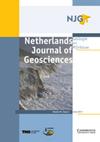Induced aseismic slip and the onset of seismicity in displaced faults
IF 2.3
2区 地球科学
Q3 GEOSCIENCES, MULTIDISCIPLINARY
Netherlands Journal of Geosciences-Geologie En Mijnbouw
Pub Date : 2022-06-29
DOI:10.1017/njg.2022.9
引用次数: 5
Abstract
Abstract We address aseismic fault slip and the onset of seismicity resulting from depletion-induced or injection-induced stresses in reservoirs with pre-existing vertical or inclined faults. Building on classic results, we discuss semi-analytical modelling techniques for fault slip including dislocation theory, Cauchy-type singular integral equations and the use of Chebyshev polynomials for their solution and an eigenvalue-based stability analysis. We consider slip patch development during depletion for faults with zero, constant static and slip-weakening friction, and our results confirm earlier findings based on numerical simulation, in particular the aseismic growth of two slip patches that may subsequently merge and/or become unstable resulting in nucleation of seismic slip. New findings include improved approximate expressions for the induced seismic moment per unit strike length and a description of the effect of coupling between the slip patches which affects both forward simulation and eigenvalue computation for high values of the ratio of fault throw to reservoir height. Our implementation based on analytical inversion and semi-analytical integration with Chebyshev polynomials is more efficient and more robust than our numerical integration approach. It is not yet well suited for Monte Carlo simulation, which typically requires sub-second simulation times, but with some further development that option seems to be within reach. Moreover, our results offer a possibility for embedded fault modelling in large-scale numerical simulation tools.诱发地震滑动和位移断层地震活动性的开始
我们研究了地震断层滑动和地震活动的开始,这些地震活动是由已经存在的垂直或倾斜断层引起的枯竭或注入应力引起的。在经典结果的基础上,我们讨论了断层滑动的半解析建模技术,包括位错理论、柯西型奇异积分方程、切比雪夫多项式的求解和基于特征值的稳定性分析。我们考虑了零、恒定静摩擦和滑动减弱摩擦的断层在损耗过程中的滑动块的发展,我们的结果证实了基于数值模拟的早期发现,特别是两个滑动块的地震增长可能随后合并和/或变得不稳定,导致地震滑动成核。新的发现包括改进了单位走向长度诱发地震矩的近似表达式,以及对滑动块之间耦合效应的描述,这影响了断层落差与储层高度之比高值时的正演模拟和特征值计算。我们的实现基于解析反演和切比雪夫多项式的半解析积分比我们的数值积分方法更有效和更健壮。它还不太适合蒙特卡罗模拟,这通常需要亚秒级的模拟时间,但随着一些进一步的发展,这个选项似乎是可以实现的。此外,我们的研究结果为大规模数值模拟工具的嵌入式断层建模提供了可能性。
本文章由计算机程序翻译,如有差异,请以英文原文为准。
求助全文
约1分钟内获得全文
求助全文
来源期刊
CiteScore
4.00
自引率
25.90%
发文量
14
审稿时长
>12 weeks
期刊介绍:
Netherlands Journal of Geosciences - Geologie en Mijnbouw is a fully open access journal which publishes papers on all aspects of geoscience, providing they are of international interest and quality. As the official publication of the ''Netherlands Journal of Geosciences'' Foundation the journal publishes new and significant research in geosciences with a regional focus on the Netherlands, the North Sea region and relevant adjacent areas. A wide range of topics within the geosciences are covered in the journal, including "geology, physical geography, geophyics, (geo-)archeology, paleontology, hydro(geo)logy, hydrocarbon exploration, modelling and visualisation."
The journal is a continuation of Geologie and Mijnbouw (published by the Royal Geological and Mining Society of the Netherlands, KNGMG) and Mededelingen Nederlands Instituut voor Toegepaste Geowetenschappen (published by TNO Geological Survey of the Netherlands). The journal is published in full colour.

 求助内容:
求助内容: 应助结果提醒方式:
应助结果提醒方式:


